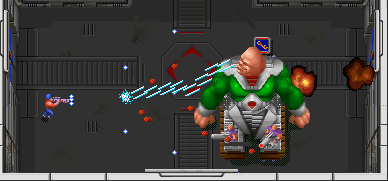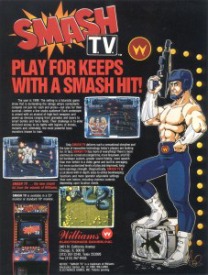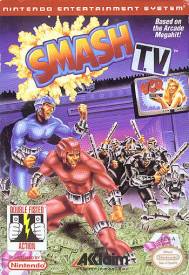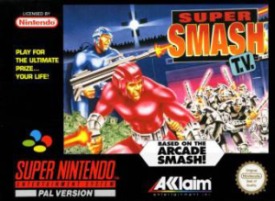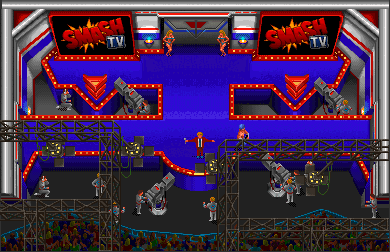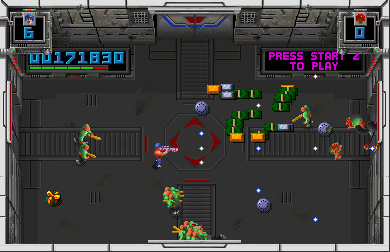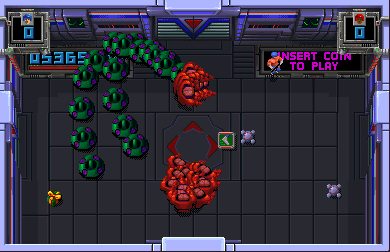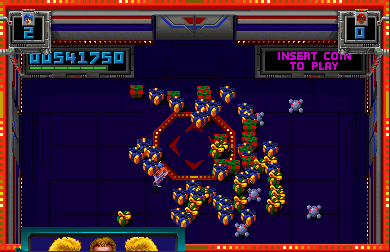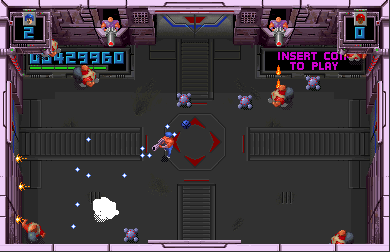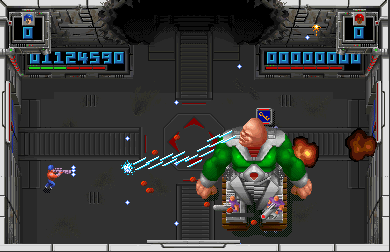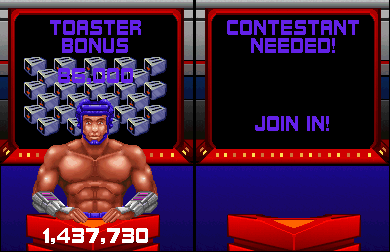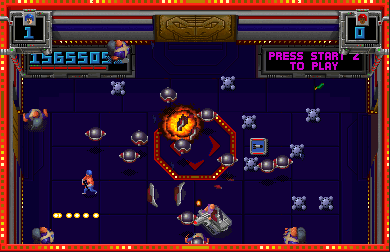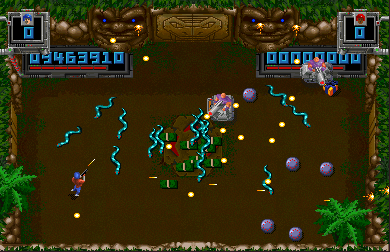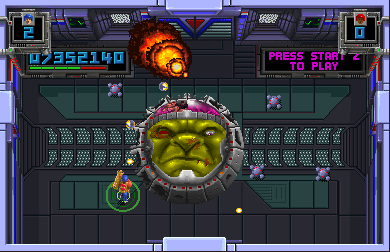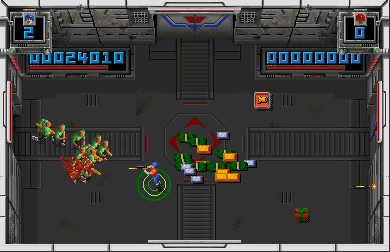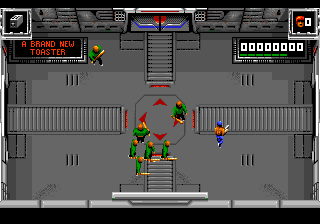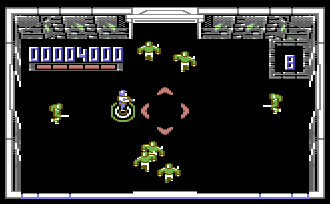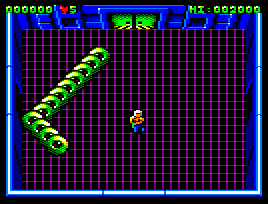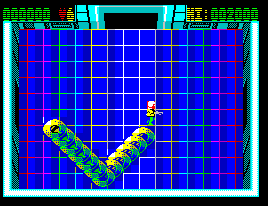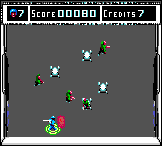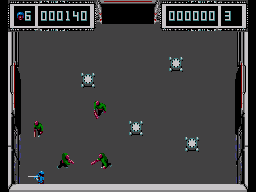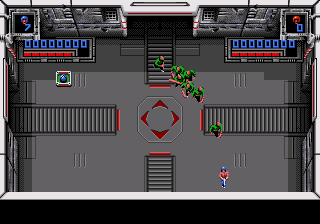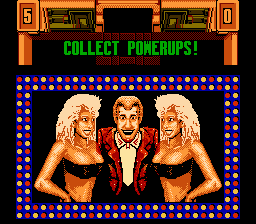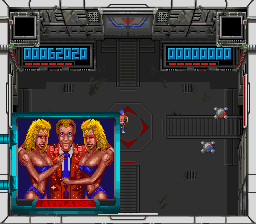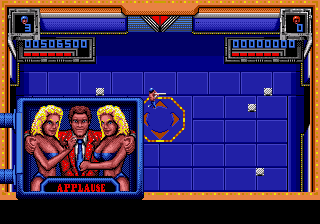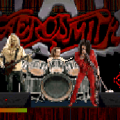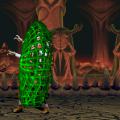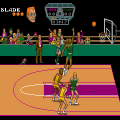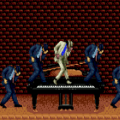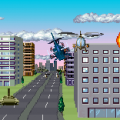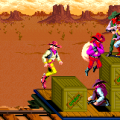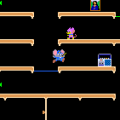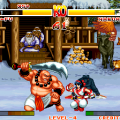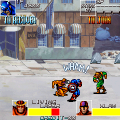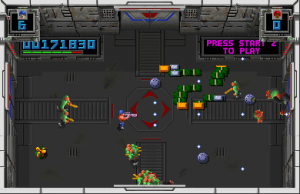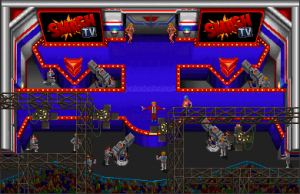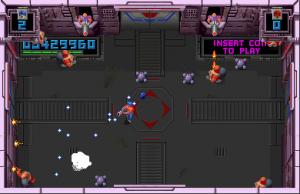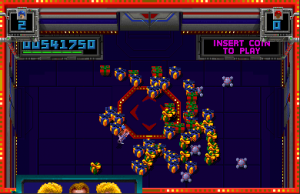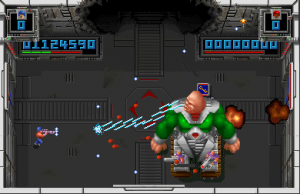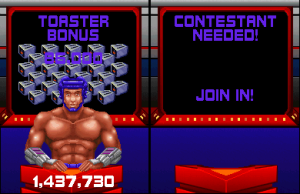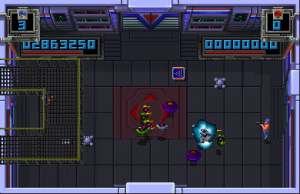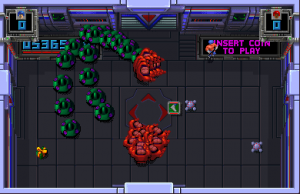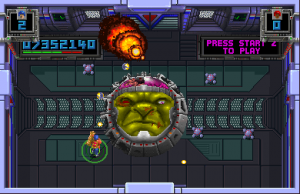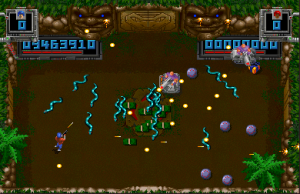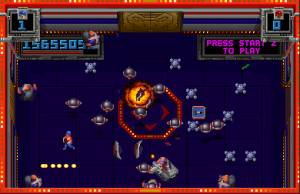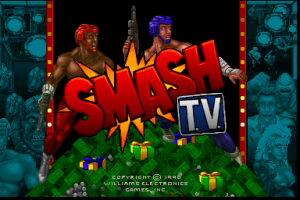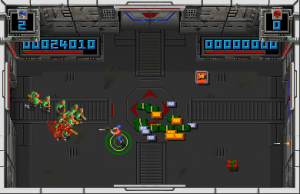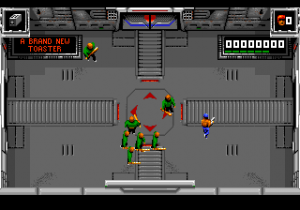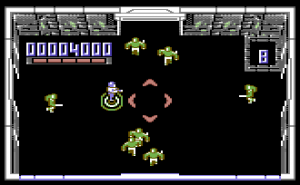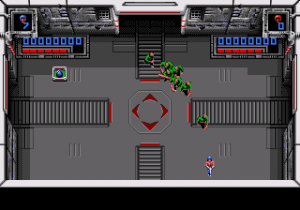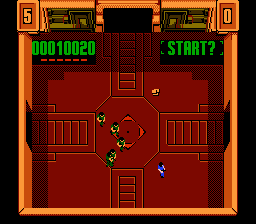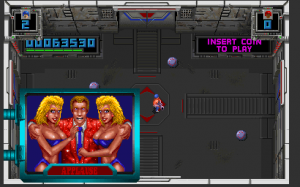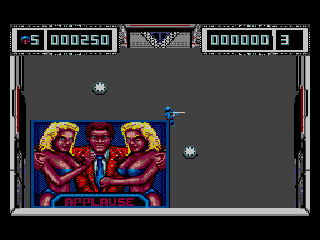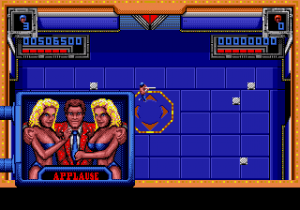For about as long as video games have been a thing, there have been attempts to take older video games and bring them into a more modern area. This trend has had a few periods where it’s been especially common, probably starting around the late ’80s to early ’90s. Very rarely, a game’s homage tends to end up even more popular than the game that spawned it, and Smash TV is probably one of those rare cases.
Smash TV is a spiritual successor to Robotron 2084, a particularly classic game spawned from the mind of pinball and arcade designer Eugene Jarvis. As one of the very games to use two sticks for movement and firing, Robotron was a game known for its brutal difficulty and insanely fast pace. Eight years later, the basic concept between the two games remain remarkably the same. Sure, arcade hardware has made considerable leaps since then, but the DNA between the games is pretty similar.
Smash TV takes place in the grim, cold future of 1999, only a few short years after the conquest of Earth by the New Order Nation. The most popular TV show of the future is Smash TV, a deadly game show where one or two shirtless guys run through room after room, shooting thousands of people for fantastic prizes like VCRs and beef. As Contestants 1 & 2, it’s up to you to survive the studio’s three arenas and win all sorts of fabulous prizes – all while being goaded on by the show’s flashy host, who is sure to absolutely not betray you in any way. The plot takes a lot of inspiration from The Running Man, only this game show happens to actually be sincere. Sure, you’ll probably die a lot, but the crowd is actually rooting for you.
The goal of the game is pretty simple. The Smash TV studio is made up of three arenas, each made up of a map of interconnected square rooms. Once you enter a room, waves of enemies will continuously enter from the four doors at its sides. Once you kill enough enemies, you’re free to enter the next room, and things go on like that until you reach the boss of the arena. Every time you clear the first room of an arena, you’re shown a map. You’ll want to pay attention to this, as you’ll often be given a choice of which door you want to exit a cleared room from. Remembering where the special prize rooms on the map were and taking the right exits can lead you to special prize rooms, where you can use to boost up your score to astronomical levels.
The left stick moves your contestant around, while the right stick fires your current weapon in whatever direction you hold it in. This means that you can move in one direction while firing in the opposite direction, and you’re basically going to need to do this all the time if you want any chance of surviving. Other than that, however, that’s basically all you need to know. All you can do, and all you really ever need to do, is run and shoot. The only button the game actually uses is the Start button, which has no use aside from continuing. And that’s a good thing, because letting go of those sticks for a moment will probably kill you.
What the game basically does is send in dozens and dozens of enemies in your general direction at once, spawning more and more without any sort of pause until you clear a room. It gets pretty intense, especially since a close encounter from any enemy or projectile will instantly kill your contestant. Given how many enemies the game throws at you at once, and the fact that you only get a single room within which to move around, keeping yourself from getting cornered and beaten to a bloody mess is always going to be your biggest priority. Sometimes, you won’t even get a full square to roam, as certain rooms will give you even less room to maneuver by walling off a big corner of the map.
The most common enemy you’ll face on your quest for prizes are bald guys carrying bats, of which the game will spawn by the proverbial truckload. A single shot from even your default weapon will instantly kill them, but their sheer numbers mean by the time you kill one group, two more spawn in. There’s quite a few more enemy types than that, as well, each of which adds their own little wrinkle to things. Tanks take a lot more shots to kill, and can spew a spread of bullets around the screen. Mr. Shrapnel is a fat guy who will explode if you don’t kill him quickly, sending a ring of deadly shrapnel throughout the room. Orbs will position themselves in place and start creating a laser grid, giving you less room to move if you don’t take them out. All of these come together to cut off your escape routes and surround you, and that’s not even counting the deadly mines scattered all over the floor. Touching one of these will make your contestant instantly explode into pieces, so they’re best avoided at all costs.
The enemies themselves aren’t that smart, as they’ll generally either just wander randomly around the arena, or they’ll take the quickest path towards you that they can. It’s their sheer numbers you really have to worry about, as without some extra firepower, you’ll never be able to kill an entire horde before they close in on you. Thankfully, the game drops in plenty of power-ups to help you out, and you’re going to want to grab every single one you can find. There are a couple of different types of shields to protect you from enemies, shoes to boost your speed, and bombs that clear the screen of enemies. The game’s even nice enough to drop the occasional extra life, although it’ll only buy you about another half minute of game time. What you’ll really want to go for, however, are the fantastic prizes that are constantly dropped in. The more cash and gold you pick up, the higher your score bonus will be at the end of an arena. You’ll also pick up various prizes that earn you instant points, like a dozen VCRs, six 2600′ inch TVs, and a couple of copies of the Smash TV home game.
Most useful of all the powerups, however, are the special weapons that spawn around the arena every so often. These will replace your default machine gun for as long as your ammo holds out, as shown by the green bar underneath your score. Special weapons come in a few different varieties, depending on the weapon icon you pick up. The most useful of these is probably the rocket launcher, since its projectiles will tear through the weaker enemies in a single shot. You will not survive long without a special weapon in hand, as your default gun is just too weak to kill anything before it rams right into your face. Something like the spread shot, on the other hand, can clear out enough of a crowd to give you enough space to dash to the next special weapon that spawns.
Every arena ends with a boss fight, a long, grueling affair where you’ll not only have to destroy the boss, but in some cases, dismantle it piece by piece. Take Mutoid Man, for example, a giant, musclely guy who somehow ended up with a tank for legs. While you’re avoiding his laser vision and trying not to get run over, you’ll have to blow off both of Mutoid Man’s arms, before moving to his head, blowing his torso open before blowing up the actual torso, and finally, blowing up his other, smaller head hiding just underneath his torso to actually kill him. It should also be noted that only special weapons can actually harm bosses, meaning you’ll have to risk death to pick up weapons that show up around the boss arena. Bosses tend to soak up a lot of damage and can take up quite a few of your credits pretty easily, usually because they’re just so huge on screen that they’re way too difficult to actually avoid.
Pretty much any sort of high level play you’ll be doing will involve finding the many secrets the arenas hold. Some rooms have hidden exits that’ll lead you to secret rooms full of goodies. You’ll need to discover all of these, as well as pick up the keys that spawn in the game every so often, to earn access to the Pleasure Dome. And what is the Pleasure Dome, you may ask? Well, it’s a secret room where the floor cycles through a bunch of retina-burning colors, while bikini-clad women can be collected like the cash and gold bars you’ve been picking up throughout the game. Totally worth it.
There was actually a bit of controversy regarding the Pleasure Dome in the original arcade release. The game would constantly egg you on to find all of the keys in order to unlock them, but there was absolutely no way to access them. In fact, they weren’t in the game at all, just an empty promise on the part of the developers for gamers to keep playing. After receiving criticism from both gamers and arcade operators, Midway issued revised ROMs which included the Pleasure Dome, if the players were skilled enough to get there.
And that’s how the game goes, quick, unrelenting, and brutal. The most valuable resource you have is space, and you’re always doing anything you can to gather as much of it as you can. The only real breaks in the action are when you’re ready to leave the current room you’re in, but even then, the game will try to kill you if you mess around for too long. The whole problem with the game is that due to its very nature, it gets pretty repetitive quickly. While the game throws in plenty of new enemies, the general concept never changes for as long as the game lasts. Eventually, it’s hard not to get sick of it by the time you start to reach the end, especially for how blatantly the game stacks things against you. On actual hardware, you likely won’t get to that point, however, because the game is so difficult that you have to be some kind of wizard to even get through the first arena without losing a credit.
Where Smash TV really shines, and what’ll drive you to finish it, is the presentation. Like any good arcade game should have, there are tons of goofy sound effects that are loud and easily recognizable. The music does a great job of establishing that frantic “game show” feel, as well. It’s a pretty nice looking game for its time, as well, with varied environments to shoot your way through. While the first two arenas look like futuristic studio sets, the third puts you in something that looks like an episode of Legends of the Hidden Temple. The bosses are comprised of several huge sprites, which get progressively more mutilated the more you fire onto them, which is a pretty nice touch. There’s plenty of ultraviolence everywhere else as well, from the way most enemies explode into red splatters, or the way your unfortunate contestant gets blown to bits when he steps on a mine.
The best parts would have to be the occasion where the host of the show will appear, popping off a quote like “Total carnage! I love it!” when you enter a particularly challenging level. He’ll even quote Robocop every so often, saying “I’d buy that for a dollar!” when you come across the first boss of the game. Also note the absolutely sinister grin he gives the two ladies by his side just before his little box scrolls off the screen. He’s just so infectiously cheerful about his job that it’s actually a shame that you have to kill him in the final stage of the game. The entire game is just so delightfully goofy that most of its issues are easily forgiven, from the way your contestant explodes into pieces from contact with a mine, to the way the levels get names like “BUFFALO HERD NEARBY”.
Overall, despite its flaws, Smash TV is definitely a game worth trying, just for the sheer spectacle of it. When you’re just getting into it, it’s incredibly fun, helped by a fantastic presentation and an intuitive control scheme. It’s the game’s “classic” arcade difficulty that really keeps it from being great the entire way through, sadly. In short bursts, however, it’s a great game for the sorts of times when you want a game about shooting a whole lot of things without much getting in the way of said shooting.
There’s a vast number of ports for the game across all sorts of computers and consoles, and these tend to vary wildly in their quality. The console ports are generally your best bet for an accurate port, although some versions do better than others at replicating the game’s control layout. The computer versions tend to go off on their own little tangent entirely, which works better on some versions than others. If you want the most authentic experience short of emulation, there are quite a few retro compilations you’ll find the game on, as well.
The big problem is that most of the ports limit the number of times you can continue, some of them not letting you continue entirely. As you’d imagine, this makes beating the game a lot more difficult without a ton of practice. Most of the older ports, aside from the SNES version of the game, also have to deal with that there just aren’t enough buttons to replicate the arcade’s control set up. They get around this in a few ways, with some ports letting you use a second controller’s D-Pad as the second stick. If you don’t have two controllers to spare, most ports will have a ‘Lock’ button that will freeze your firing direction in place. It’s a decent compromise, although it’s lacking the precision a second stick offers.
The Super Nintendo version, renamed Super Smash TV on the box and cartridge, is actually probably one of the best ports you’ll find. The second stick has been remapped to the face buttons of the SNES controller, which generally works just as well. As far as gameplay’s concerned, it plays almost exactly like the original game, with only a slight drop in speed. Surprisingly, they’ve even managed to fit in most of the violence from the arcade version, with only the big bloodsprays from some of the bosses being removed. There’s also a secret “turbo” mode, unlocked by picking up five question mark powerups and beating the game. If you can do this, you’ll begin a second loop where the game plays at double speed and sends even more enemies at you. “Good luck! You’ll need it!” indeed.
The NES version, while cut down pretty heavily from the arcade version, is actually pretty enjoyable. This is mostly due to the fact that there are generally never as many enemies on screen as once as the arcade has, and the pace is somewhat slower. This means that, with some practice, it’s actually possible for actual human beings to clear this port on a single credit. And that’s good, because you don’t really have a choice: Run out of lives, and you’re done. The graphics are cut down pretty heavily, especially with the shade of orange that’s pretty much all over everything, but there’s a surprising amount of digitized speech kept from the arcade. It also supports the Four Score four player adapter, so you can have two players, each using two joypads or joysticks, for the best multidrectional control. It’s actually a pretty fun game on its own, differences from the original version aside, and it’s worth seeking out. It’s also interesting to note that the cover artwork of the NES (and some of the European computer ports) are censored, removing the gun from the blue guy’s arms.
The Genesis version is more or less inferior to the SNES version in just about every way, sadly. The controls don’t suffer that much from a three button pad, since you can get by just using the button that locks your firing direction in place. Something about this particular version feels very off, however, and it feels like all the hitboxes are somewhat off center, which makes an already difficult game even harder on you then it already is. While you do get seven lives per credit, you only get a single continue per player, which means even beating the first arena isn’t a sure thing. All the graphics have been redrawn entirely, with almost everything coming out worse, and even a Matt Furniss soundtrack doesn’t do much good for this port.
But the Game Gear port makes the Genesis version look like the arcade game in comparison of how awful it is. It should be noted, first off, that this is a terrible, terrible game to have on a handheld. This is a game where tons of enemies are constantly moving around en masse, and when you put on a screen as blurry as the Game Gear’s … well. The result is a game where you have absolutely no room to move and you have absolutely no idea what anything is, even if you happen to be playing on an emulator. That might not even be so bad if the game didn’t run at about five frames per second, meaning that you’re dealing with a choppy, indistinct mess, especially when you figure the Game Gear’s screen into things. The only good thing about this port is that the main theme sounds kind of nice. That’s literally the only redeeming thing.
The Master System is based off of the Game Gear port, only with a larger screen and bigger sprites occupying it. This is good, as this lets you see the many underlying problems with these two ports much more clearly. You’re still dealing with a choppy framerate that’s only marginally more playable then the Game Gear version. The many other reasons this version as well as the Game Gear version are so unplayable is that everything is too damn fast, meaning that every enemy rockets around the screen before you can react. Oh, also, every enemy now kills you on touch. Actually, they don’t even have to touch you to kill you. That pretty much kills any chance of having a good time with this port right there. But hey, the one single song in the game is pretty nice.
The ZX Spectrum version feels like a different game entirely, which makes sense, given the limitations the system had. While the basic concept remains, this port has a much different feel to it, so much so that it almost feels like an entirely new game. Most of the enemies that would normally show up much later in the game, like the tiny snakes, show up right from the first room here, and they usually spawn right in the middle of the screen. Even the guys with the bats behave completely differently, spawning in the middle of the room and moving around randomly, which makes them much more dangerous. The game never spawns nearly as many enemies at once as it would in the arcade version, which might explain some of the enemy behavior changes.
Aside from that, though, it’s still a pretty similar game, although the gameplay differences might take time to get used to. It’s also a pretty impressive feat for the hardware, since it manages to hold together with so many enemies on screen pretty well, without much of the “bleeding colors” you usually get on the hardware at all. It’s still not an especially pretty game, however, and the sound effects are more or less non-existent, aside from a nice chiptune cover of the game’s main theme on the title screen. It’s a pretty good shooter for the hardware, although it’s best thought of as its own, unique game that shares a similar concept.
The Amstrad plays about the same as the ZX Spectrum version. It does, however, look much nicer than the Spectrum version, given that the CPC version uses more colors and has a generally chunkier look to it. The sound effects are also generally much meatier, which definitely beats out the static that the Spectrum version uses for pretty much everything. Overall, it’ll really depend on your preference on what obscure British computer you prefer, since both versions play nearly identically.
The Commodore 64 version is much closer in terms of gameplay to the original arcade version, and it’s actually a pretty playable port. You can use both of the C64’s joysticks to play the game just like you would in the arcade, with the tradeoff being that there’s no two player mode. Surprisingly, this port is actually one of the easier ones you’ll find, even more so than the NES version. There’s not quite as many enemies sent out at once, the pace is a little slower, and the game spawns extra lives a lot more often. Even the graphics come through pretty well, including the big boss sprites, and the only real flaw is that there’s no in-game music, leaving everything somewhat quiet. It’s still a pretty great port, otherwise, and it’s worth at least emulating.
The Amiga version looks and sounds a good deal closer to the arcade version, since it includes a lot of the digitized speech and sound effects the 8-bit versions were missing. It also includes the two player mode, and it even lets you plug in four Amiga joysticks for a “2 players, 2 joysticks mode”. Unfortunately, something about this version feels a little choppier than other versions, and it has the same issue as the Genesis version where the hitboxes feel ever so slightly off center. Combined with the fact this port is just as tough as the arcade version, it can be a little difficult to actually play. The sprites are also much bigger in this version, which can occasionally make things even more difficult for you. There’s no in-game music, either, even though the system probably should have been able to support it. It’s not an awful port, especially for the home computers, and it’s nice to have a computer port with a two player mode. The Atari ST version, aside from a smaller color palette and weaker sound hardware, including a lack of digitized speech, is exactly the same as the Amiga version. Unfortunately, the C64 version is still a little more fun, given its kinder difficulty and smoother speed.
You can find Smash TV on the Arcade Party Pak for the PS1, which isn’t much more than a no-frills emulation of the arcade game. It does come with some video interviews with the developers, however. The game can also be found on the Midway Arcade Treasures compilation for PC, GameCube, PS2, and XBOX, as well. This is basically a standard emulation of the arcade version without any notable extra features. It does, however, support the right analog stick for something closer to the original arcade control scheme. While playable, it’s subject to slowdown and music glitches. The Xbox 360 version is an emulation of an arcade game, much like the other ports to modern systems. What makes this one unique is that it features online play for two players over Xbox Live, as well as having achievements. Unfortunately, with Midway’s bankruptcy, this version was taken off of the service some time ago. Finally, you can find the game on the Midway Arcade Origins compilation released for the XBOX 360 and PS3, which Is, once again, an emulation. No online play, either, but hey, at least you get leaderboards. Everybody likes leaderboards, right?
Comparisons
Comparisons – The Host
